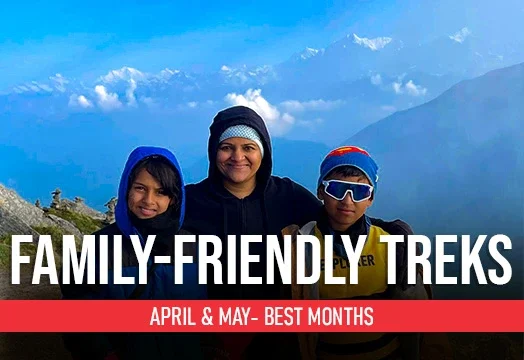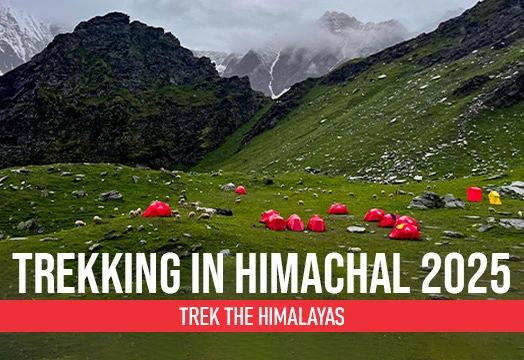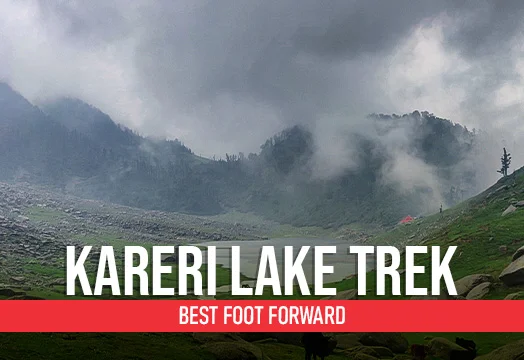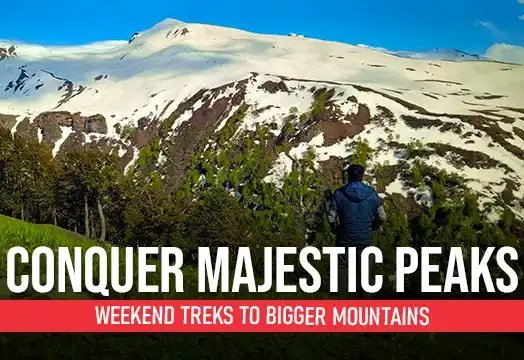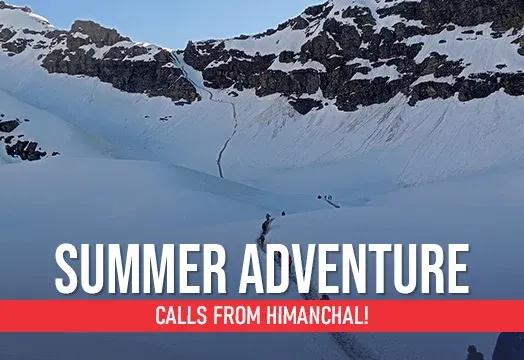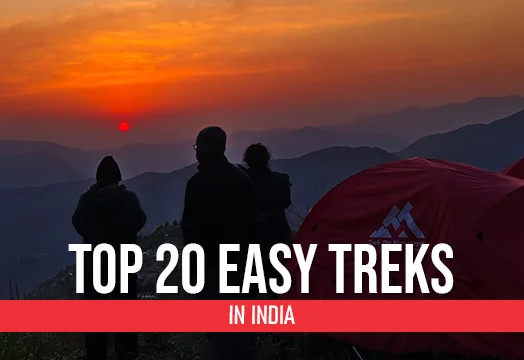Kareri Lake Trek

Region
Himachal Pradesh | India

Duration
3 Days

Max Altitude
9700 Ft.

Trekking Km
26 KM

Grade
Easy
Get in Touch with Our Trek Expert
91 8265906135 info@trekthehimalayas.comMonday - Saturday: 10 AM to 06 PM (GMT +5:30)
5500 /Person
- November-2025
- April-2026
- May-2026
- June-2026
- 5% GST will be applicable on Trek Cost and Add-ons
- Services Dharamshala to Dharamshala.
- Pick-up time is 10 am, and drop time is 5:30 pm.
Add-ons
Insurance 105
- Insurance is mandatory.
- It is available for Indian citizens only.
- Non-Indians have to take insurance on their own.
- If you already have the high altitude trekking insurance, email for a refund after booking.
- The cancellation policy will be implemented in accordance with the trek cancellation policy.
- For more details about insuranceclick here
Offload 1000
- Backpack offload is optional.
- Choose add-ons during booking. If missed, log in and add them later.
- Book off-load at least 10 days before the trek.
- For offline bookings at the base camp, a convenience fee of Rs. 1500 applies.
- Cancellations made before the trip date will receive a full refund.
Single Occupancy Tent 1200
- Single Occupancy Tent is optional.
- Choose add-ons during booking. If missed, log in and add them later.
- Book Single Occupancy Tent at least 10 days before the trek.
- Cancellations made before the trip date will receive a full refund.
Get in Touch with Our Trek Expert
91 8265906135info@trekthehimalayas.com
Monday - Saturday: 10 AM to 06 PM (GMT +5:30)
Overview
Trek Name: Kareri Lake Trek
Days: 3
Adventure Type: Trekking
Base Camp: Kareri Village
Season:Summer | Autumn |
Month:April | May | June | September | October | November |
Country: India
Altitude: 9700 Ft.
Grade: Easy
Rail Head: Pathankot is the nearest rail head to the base camp
Stay: Camping (Twin sharing)
Food: Meals while on trek (Veg + Egg)
Location: Himachal Pradesh
Distance: 26 Km.
Trail Type: One way trail | Camping in various locations, starting and ending at the different point.
AirPort: Kangra Gaggal Airport which is 13km away from Dharamshla
Highlights:
- 5% GST will be applicable on Trek Cost and Add-ons
- Services Dharamshala to Dharamshala.
- Pick-up time is 10 am, and drop time is 5:30 pm.
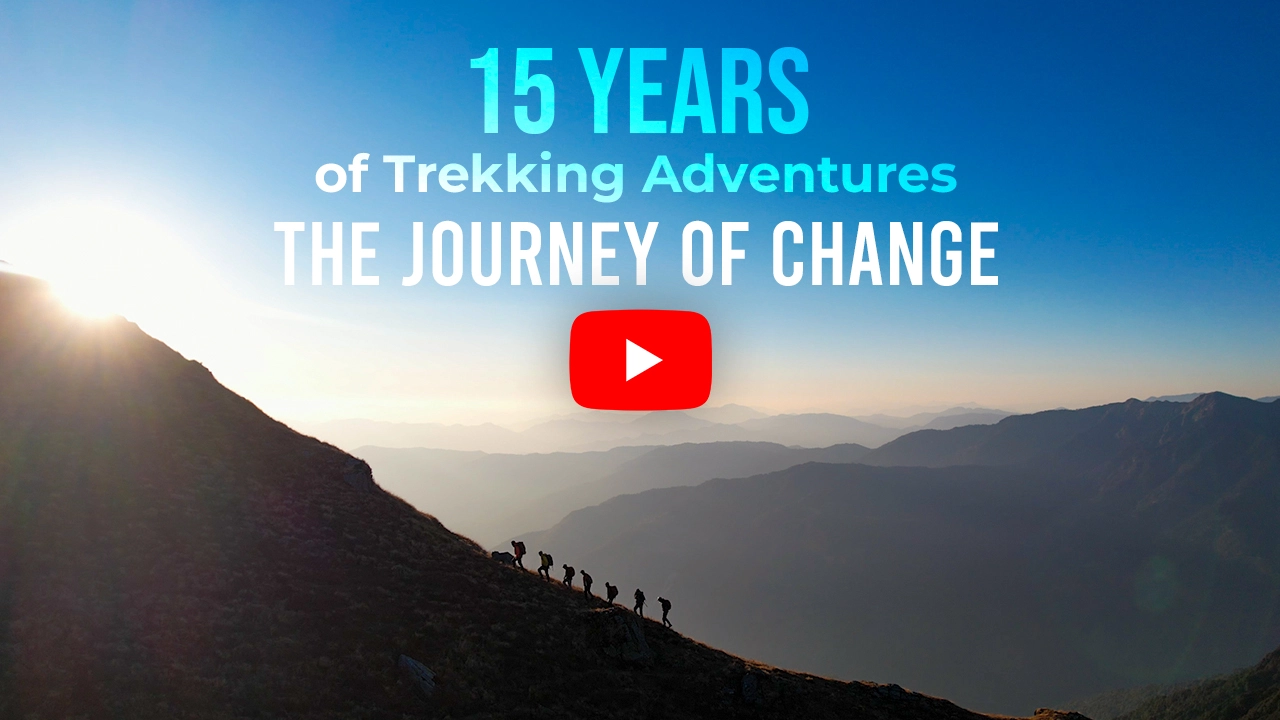
Why Is Kareri Lake a Must-Do Trek?
- The Kareri Lake trek is a short yet spectacular trek in Himachal Pradesh.
- This trek leads you to the iconic Kareri Lake, that beautifully sits amid the Dhauladhar mountains and appears to be even more mesmerizing when the surrounding peaks reflect on it.
- Being by the Kareri lake is a tranquil experience, as you get a view of the lake along with lush greenery and peaceful environment around.
- The trek passes through a variety of ecosystems including forests and meadows, allowing you to witness a wide range of flora and fauna.
- Along the way, you will pass through a small area inhabited by the Gaddi people, who are known for their traditional shepherding lifestyle.
- The trek is full of picturesque landscapes, offering you a chance to capture countless pictures of the beautiful region. Every step unveils a new and beautiful frame.
- One of the best parts of the Kareri Lake trek is an opportunity to camp at the Liyoti campsite that is surrounded by majestic mountains and forest. Camping here in a serene environment allows you to relax, unwind, and enjoy the peaceful surroundings.
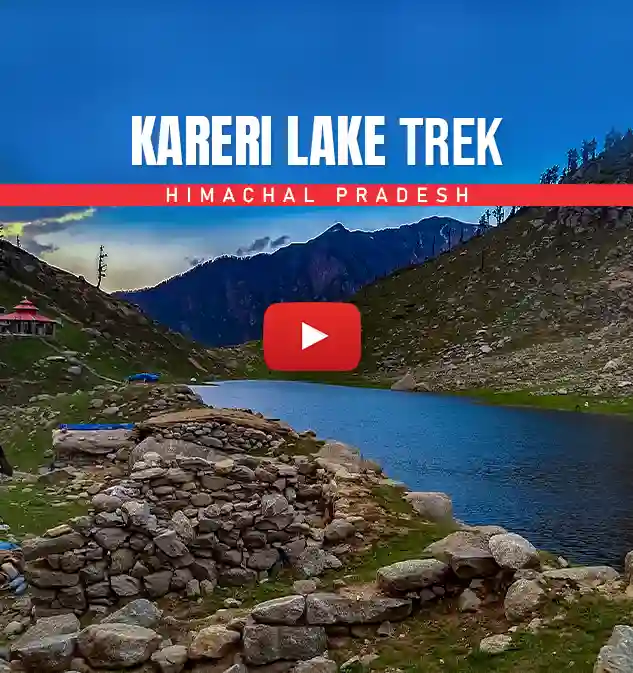
Who Can Participate
- Age Requirement:
- Minimum 7 years.
- First-timers are welcome, though prior trekking experience is preferred. Good fitness is a must.
- Fitness Criteria:
- If the trekker wants to carry a backpack, he/she should be able to carry a 10-12 kg backpack. If opt Off-load option then the trekker should be able to carry a 3-5 kg backpack.
- If a trekker's BMI is more or less than the normal range (18-29), please consult our Trek Coordinator before booking.
Kareri Lake Trek Itinerary
Dharamshala to Kareri Village Drive and Trek to Liyoti
- Altitude (Dharamshala): 1,450 m/ 4,750 ft
- Altitude (Kareri Village):1,800 m/ 5,900 ft
- Altitude (Liyoti): 2,450 m/ 8,000 ft
- Drive Distance (Dharamshala - Kareri Village): 25 km | 2 hrs
- Trek Distance (Kareri Village - Liyoti): 7 km | 4-5 hrs
- Pickup Point: Dharamshala Bus Stand (ISBT) 10:00 AM.
- Difficulty: Mostly ascent, steep ascent in some parts.
- Trail Type: Mixed forests of Pine, Deodar, and Broadleaf.
- Packed snacks provided for trek & hot lunch at campsite.
- Water source: Many small springs along the way and a big waterfall.
- Shops available on the way (only in peak season).
- You can leave extra luggage in Kareri Village.
- Last ATM Point: Dharamshala.
- Receive briefing from Trek Leader at Kareri Village.
- Stay in tents (twin-sharing).
Today we will drive from Dharamshala to Kareri Village along a scenic route with scenic vistas of snow-capped mountains and then Trek from the village to Liyoti our first campsite on the way to Kareri Lake.
The pickup will be arranged by TTH from Dharamshala, where we will pick you up at 10:00 am and drive to Kareri Village. Kareri Village is situated at a distance of 25 km and it takes approximately 2 hours to reach the village. On reaching Kareri village, our trek leader will give you a brief overview of the entire tour. The local people of Kareri village belong to the Gaddi tribe and you can get glimpses into their everyday lifestyle. The trek starts from this village through mixed forests of pine, cedar, and broadleaf. The vegetation is quite thick here and be mindful of your steps as pine needles are strewn on everyone on the trail and it can get a little slippery. You can opt to leave your extra luggage at Kareri Village and pick it up on the way back.
The trail to Liyoti campsite is pretty scenic and you will stroll along a gushing river, cross bridges and even walk on boulder stretches to arrive at your destination. There will also be a waterfall on the way, a picturesque sight to behold, and a great water source to refill your water. Along the path, the canopy of forest cover is pretty low making it an ideal spot for birds to nest. You may spot native birds like Pheasants and Blue Magpie. Packed snacks will be provided to energize you on the way. Liyoti campsite is located in an alpine grassland at an altitude of 8,000 ft where you will stay the night in camps. A hot lunch will be served at the campsite, once you reach here. You can spend the day at your leisure walking around the campsite and at night you can retire in your tents post-dinner.

Trek To Kareri Lake and Back To Liyoti
- Altitude (Liyoti): 2,450 m/ 8,000 ft
- Altitude (Kareri Lake): 2,950 m/ 9,700 ft
- Trek Distance: 12 km | 7-8 hrs (Both Sides)
- Altitude Gain: 500 m
- Difficulty: Gradual and easy ascent.
- Trail Type: Grass meadows and boulders.
- Water Source: Many water points (trek is along a river).
- Many shops along the way (only in peak season)
- Packed snacks for the trek and hot lunch at campsite.
- Kareri Lake holds several holy stories.
- Stay in tents (twin-sharing).
We will start our morning with a hearty breakfast and a cup of tea and move onward towards Kareri Lake. Today you will trek through towering columns of Oak and Pine trees with beautiful views of the Himalayas. Initially, the trek is a little muddy and rocky which soon gives way to a dense forest. You will walk along a mountain stream called Nyund Nallah and as you continue your climb uphill, the flow of the stream increases as we approach closer to its source - the Kareri Lake. You may spot a few Gaddi huts on the way built by the nomadic Gaddi shepherd tribe in the Kangra region. These huts are makeshift shelters that these shepherds build on their way with their livestock.
Follow the trail across the banks of the river and you will have to cross it a few times to arrive at the Lake. The lake water is crystal clear and is surrounded by greenery all around. Treat your eyes to resplendent views of the Dhauladhar Range from here. There’s a Shiva temple near the lake that you can explore. After enjoying the serenity of the lake and exploring the temple, we’ll begin our descent toward the Liyoti campsite. The trail winds gently through alpine meadows and dense forests, offering glimpses of the valley below as the landscape gradually changes. By the time we reach Liyoti, the setting sun might just cast a golden hue over the valley, marking the end of another beautiful day in the mountains.
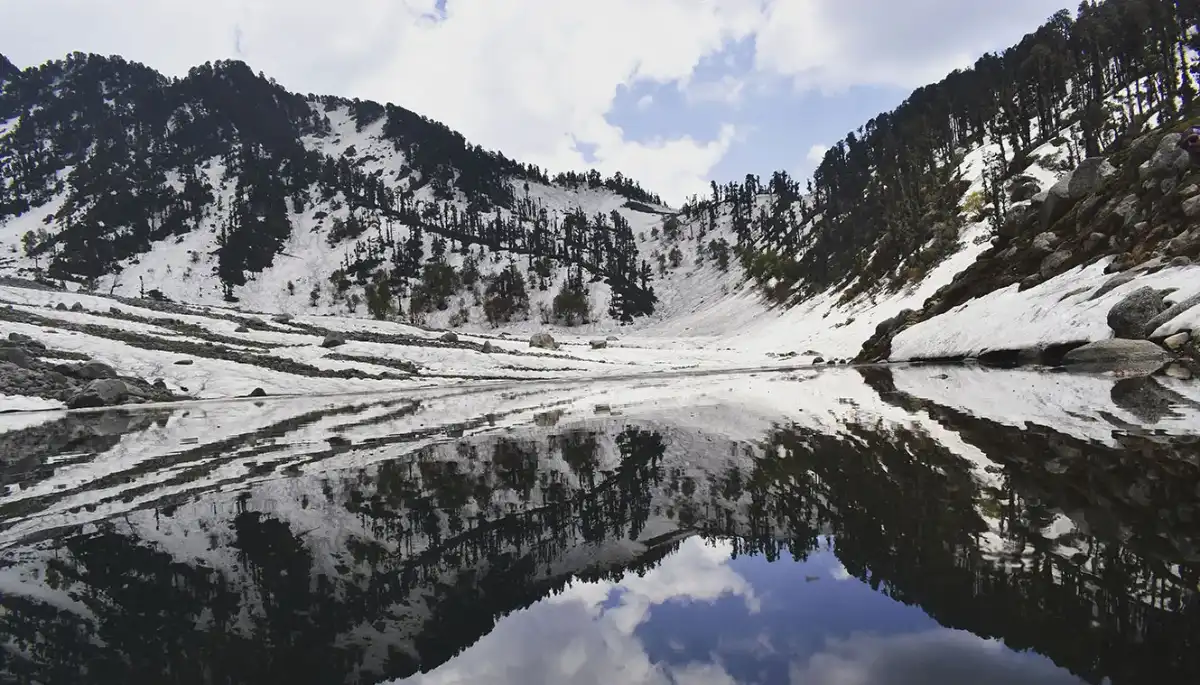
Descend To Kareri Village | Drive Back To Dharamshala
- Altitude (Kareri Village): 1800 m/ 5,900ft.
- Altitude (Dharamshala): 1,450 m/ 4,750 ft.
- Trek Distance: 7 km | 3-4 hrs
- Drive Distance: 25 km | 2 hrs
- Difficulty: Mostly decent, steep descent in some parts.
- Water sources: Many water points (trek is along a river).
- Packed lunch will be provided on the way.
- Shops on the way (only in peak season).
- Reach Dharamshala by 5:30 PM.
Wake up to the crisp mountain air under a clear blue sky, feeling refreshed after a peaceful night of camping. After a hearty and delightful breakfast, you’ll have some time to explore the surroundings and soak in the final moments of mountain calm before we begin our descent to Kareri Village. Take a moment to admire the breathtaking views one last time as you bid farewell to the mountains—for now.
The descent to Kareri Village spans about 7 km and usually takes 3 to 4 hours to complete. We’ll follow the same scenic trail we took on our way up, with the path gently winding downwards, occasionally giving way to steeper sections.
From Kareri, we’ll begin our drive back to Dharamshala, which lies about 25 km away and takes approximately 2 hours. Expect to reach Dharamshala by around 5:30 PM, bringing our beautiful trek to a close—leaving us with warm memories, quiet smiles, and the lingering magic of the mountains.

Day-1: Dharamshala to Kareri Village Drive and Trek to Liyoti
- Altitude (Dharamshala): 1,450 m/ 4,750 ft
- Altitude (Kareri Village): 1,800 m/ 5,900 ft
- Altitude (Liyoti): 2,450 m/ 8,000 ft
- Drive Distance (Dharamshala - Kareri Village): 25 km | 2 hrs
- Trek Distance (Kareri Village - Liyoti): 6 km | 4-5 hrs
Day-2: Trek To Kareri Lake and Back To Liyoti
- Altitude (Liyoti): 2,450 m/ 8,000 ft
- Altitude (Kareri Lake): 2,950 m/ 9,700 ft.
- Trek Distance: 14 km | 7-8 hrs (Both Sides)
Day-3: Descend To Kareri Village | Drive Back To Dharamshala
- Altitude (Kareri Village): 1800 m/ 5,900ft.
- Altitude (Dharamshala): 1,450 m/ 4,750 ft.
- Trek Distance: 6 km | 3-4 hrs
- Drive Distance: 25 km | 2 hrs
Kareri Lake Trek Graph
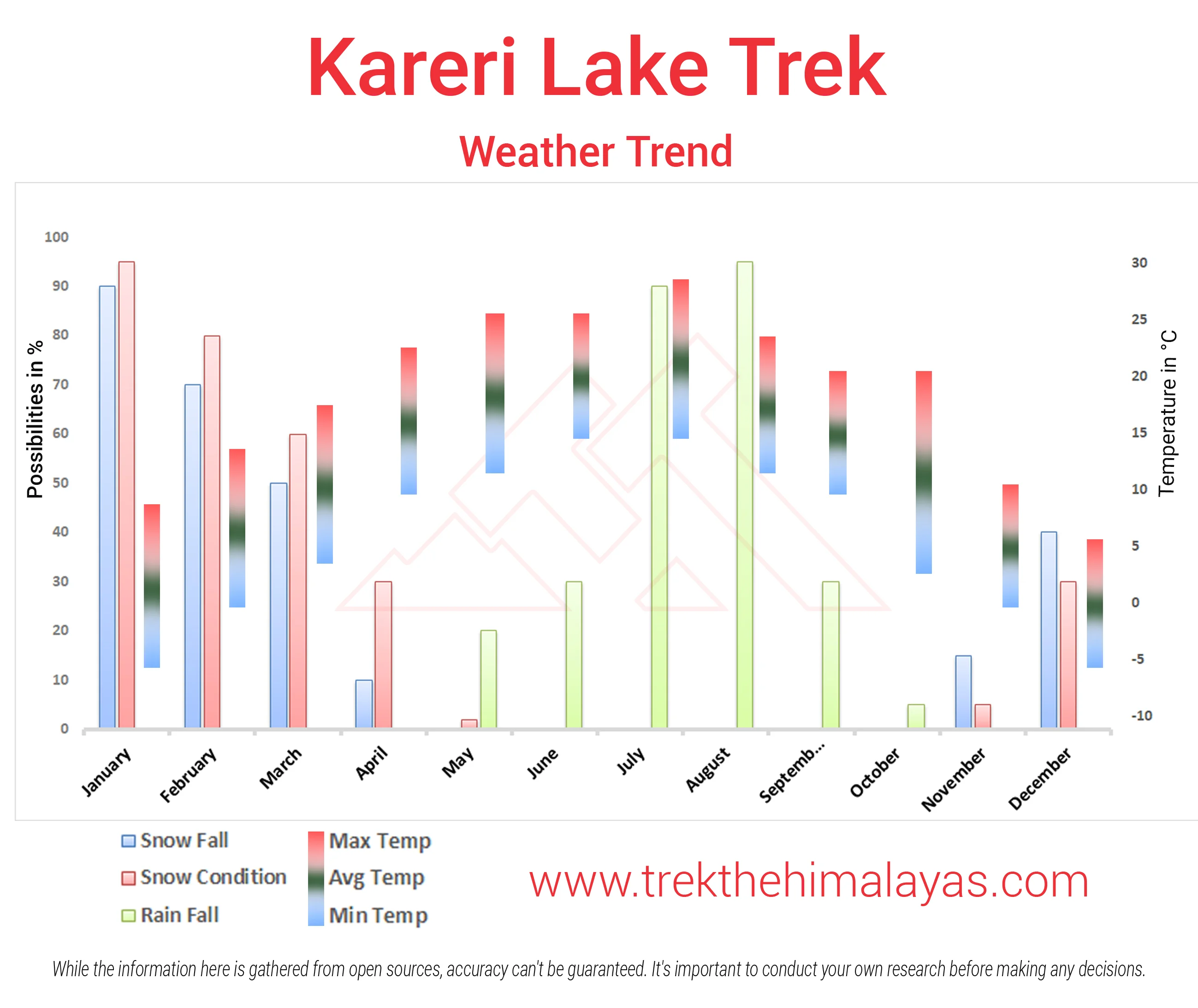
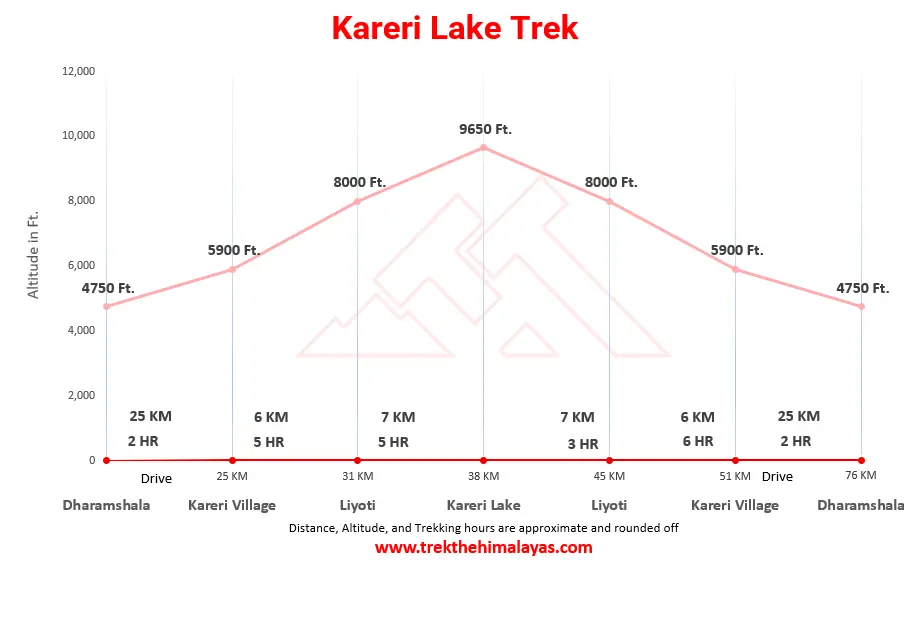
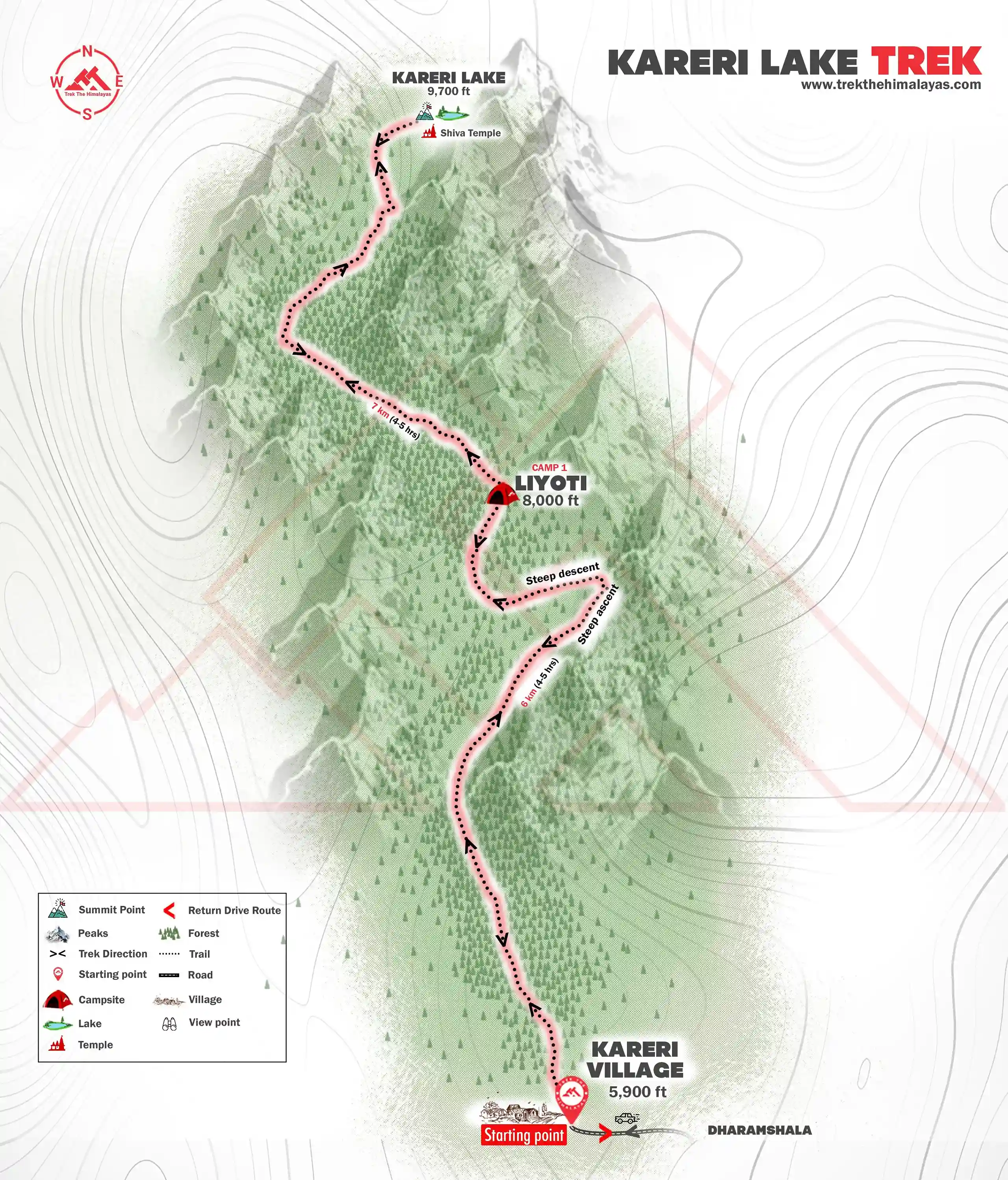
- Pulse rate at rest must be in between (60 to 100 beats per minute).
- Blood Pressure Reading must be in between (DIASTOLIC 75 – 85, SYSTOLIC 100 - 130 mm Hg).
- Respiratory rate at rest must be in between (12 to 20 breaths per minute).
- Should not have Liver and kidney issues.
- Should not have Diabetes Mellitus, Bronchial Asthma, Heart problems, Hypertension, etc.
- No pacemaker implant.
- People with Sinus issues, Epilepsy please contact to trek coordinator before booking the trek.
- If your BMI is not normal, Please contact our Trek coordinator before Trek booking.
Medical & Disclaimer Form (Mandatory Documents) Click here to download Medical & Disclaimer Form
- Government Employees can avail the benefit of Special Casual Leave (SCL) when they join us for a trekking expedition. As per the rules of the Pay Commission, Special Casual Leave can be availed for up to 30 days in a calendar year for trekking/mountaineering expeditions through a registered organization. Trek The Himalayas is a registered adventure tour operator by the Indian Mountaineering Foundation (IMF) and the Ministry Of Tourism (MOT).
- Trekkers have to apply for leave at least 20 days before the trek departure date.
- This service is exclusive to Indian government employees and is applicable only for treks within India.
- Do mail at info@trekthehimalayas to apply and mention your booked trek date and trek name.
- Junior trekkers (below 15 years) should have a company of parents/guardians.
- Trekkers between 15 to 18 years can come solo with the disclaimer form signed by parent/guardian.
- Medical & Disclaimer Form (Mandatory Documents) Click here to download Medical & Disclaimer Form
Important Links
- Mandatory Documents to Bring on A Trek Click Here.
- How to pay Add-ons, Submit Medical Forms, and Dietary Preferences Click Here to watch Video
How To Reach
It is essential for everyone to arrive at Dharamshala Bus Stand (ISBT) (10:00 am).
Once you reach the Dharamshala Govt. Bus Stand/ ISBT. TTH will take care of your further travel, which is also the starting point of the trek.
-
Reach by Bus.
Take overnight bus to Dharamshala from Delhi or Chandigarh, taking a bus from Chandigarh is the most ideal option.
• Chandigarh to Dharamshala Bus: 7 hours.
• Delhi to Dharamshala Bus: 12-13 hours is hectic and takes more time.
We always recommend going for the govt. Buses over the private ones outside the bus station as based on the experience we have found that there are very high chances of delay involved with private buses. Also, govt. Buses are always more reliable. Whichever bus you choose, just make sure to reach Dharamshala at least by 7-8 am positively.
-
Take a flight to Gaggal Airport.
The nearest airport is at Gaggal, about 13 kilometres away from Dharamshala. Tourists from other parts of India would find it easier to take a flight till Chandigarh and book a taxi for their onward journey to Dharamshala, which is about 237 kilometres away.
-
Reach by Train.
You can even come via train; Pathankot railway station is from where you can get direct buses to Dharamshala that is 85 km and takes 3hrs.
.
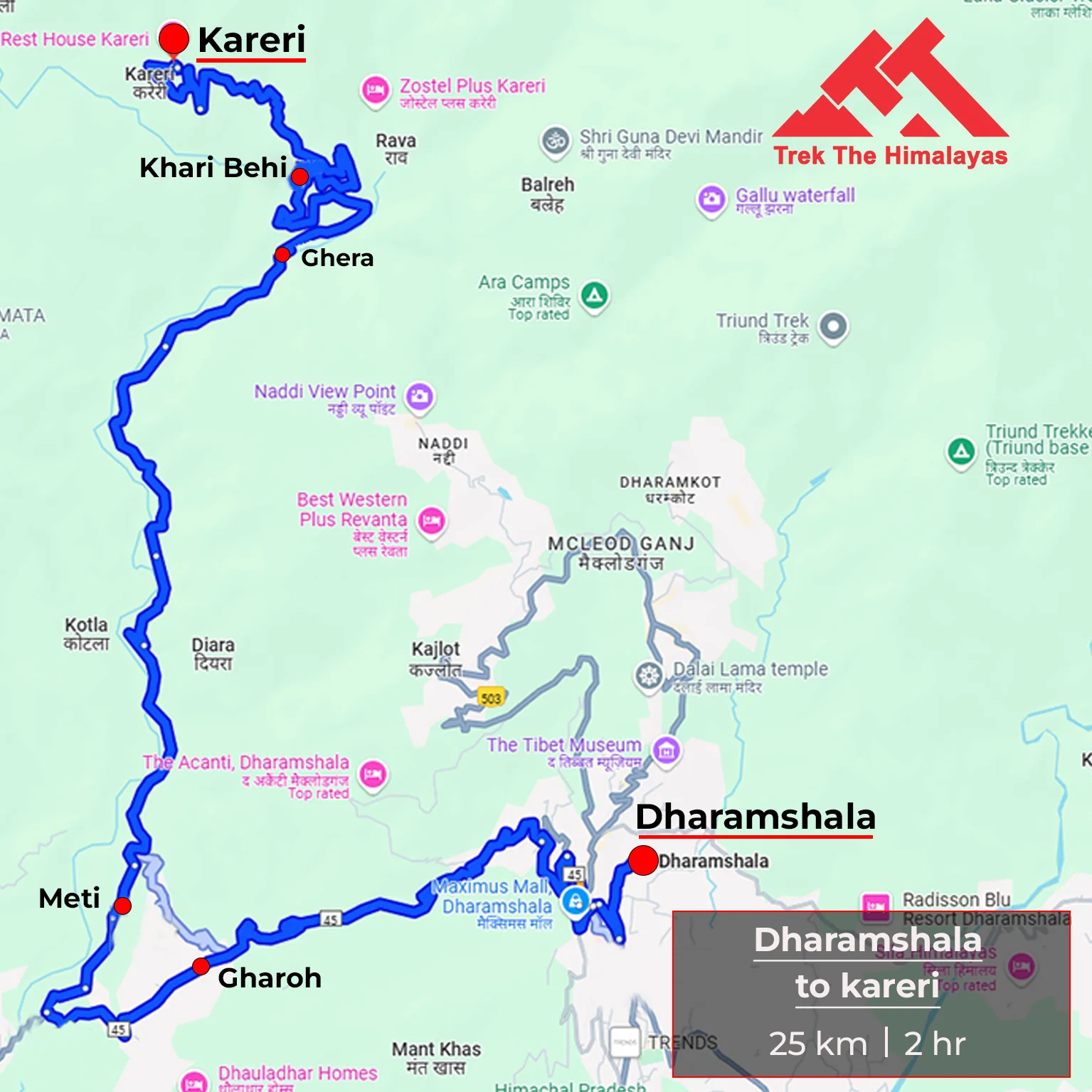
Cost Terms
Inclusion
1. Accommodation (as per the itinerary):
- Camping during the trek.
2. Meals (Veg + Egg):
- Meals while on trek (Veg + Egg).
3. Support:
- 1 Versatile base camp manager: handles communication and deploys extra manpower in emergencies.
- 1 Mountaineering & First aid qualified professional trek Leader.
- 1 Experienced high altitude chef.
- Local experienced guides (Number of guides depending on the group size).
- Enough support staff.
4. Trek equipment:
- Sleeping bag, Sleeping liners (if required), Mattress, Utensils.
- 3 men all season trekker tent (twin sharing), Kitchen & Dining tent, Toilet tent.
- Camping stool, Walkie talkie.
- Ropes, Helmet, Ice axe, Harness, Gaiters & Crampon (if required).
5. First aid:
- Medical kit, Stretcher, Oxygen cylinder, Blood pressure monitor, Oximeter, Stethoscope.
6. Transportation (as per the itinerary).
7. Mules/porters to carry the central luggage.
8. Cloakroom facility available at
the base
camp for additional luggage.
9. All necessary permits and entry
fees, Upto the amount charged for Indian.
10. Services from
Dharamshala to Dharamshala.
11. Trek
Completion Certificate.
Exclusion
- Insurance (For non-Indian Nationals, NRI or OCI card holders).
- Food during the transit.
- Any kind of personal expenses.
- Mule or porter to carry personal luggage.
- Emergency evacuation, hospitalization charge, etc.
- Any extra costs incurred due to extension/change of the itinerary due to natural calamities roadblocks, vehicle breakdown, etc. factors beyond our control
- Anything not specifically mentioned under the head Inclusion.
Things can be provided on demand and availability (participant has to pay extra for these things).
1- Satellite phone/set phone - is a type of mobile phone that connects via radio links via satellites orbiting the Earth instead of terrestrial cell sites like cellphones. Therefore, they can operate in most geographic locations on the Earth's surface.
2- Gamow/PAC HAPO Bag (Portable Hyperbaric Bag) - is a unique, portable hyperbaric chamber for the treatment of acute mountain sickness (AMS), also known as altitude sickness.
3- AEDs (Automated External Defibrillators) - are portable life-saving devices designed to treat people experiencing sudden cardiac arrest, a medical condition in which the heart stops beating suddenly and unexpectedly.
Cancellation Terms
To request a cancellation, please email us at info@trekthehimalayas.com using your registered email ID.
Cancellations prior to 25 days from the start of the Trip
Refund Options
- 5% deduction of trek fee
- 100% cash voucher for any trip till one year
- Transfer your trek (any trek, any date) to your friend
Cancellation between 24 days and 15 days to the start of the Trip
Refund Options
- 30% deduction of trek fee
- 100% cash voucher for same trip till one year
- 85% cash voucher for any trip till one year
- Transfer your trek (same trek, any date) to your friend
Cancellation between 14 days and 10 days to the start of the Trip
Refund Options
- 50% deduction of trek fee
- 80% cash voucher for same trip till one year
- 70% cash voucher for any trip till one year
- Book the same trek, in the same season, with any other batch
- Transfer your trek (same trek, any date) to your friend
Cancellation less than 9 days to the start of the trek.
Refund Options
- No cash refund
- 20% cash voucher for the same trip till one year
- 10% cash voucher for any trip till one year
- Transfer your trek (same trek, same date) to your friend
Cancellation Policy (Emergency Cases):
In case of a death in the immediate family (parents, siblings, spouse, children) or if the trekker is hospitalized (min. 48 hours) or suffers a fracture (leg/arm) within a week before the trek, even if canceled a day before:
90% refund in cash & 10% as a voucher (valid for 1 year, for any India trek)
Valid documents required. We’re here to support you during tough times.
Note:
- Change of trek batch is dependent on the availability of seats in the batch
- In case of transferring a trek to a friend, he/she should satisfy all the mandatory requirements put forward by TTH
- TTH holds the right to change/cancel the policies, without prior notice
Booking and Payments
- The Participant is responsible for verifying the accuracy of all details, including Trip dates and personal documentation, at the time of booking.
- Payments must be made in accordance with the timelines and instructions provided by TTH. Late payments may result in cancellation of booking without refund.
- In the event of a cash refund, only the portion of the payment made in cash shall be eligible for refund in cash. Any booking made using voucher, discounts, promotional codes, or through any non-cash mode of payment shall not be eligible for a cash refund under any circumstances.
- Refunds, if applicable, shall be processed within 15–30 working days of confirmation.
- Voucher Terms
- This is a non-transferable voucher
- The voucher cannot be merged with any other offer of Trek The Himalayas
- The voucher is valid for Trek booked directly with Trek The Himalayas in India
- To avail the voucher please use your register phone number or e-mail id
- All the other Terms of booking a trek with Trek The Himalayas are applicable to the voucher
Itinerary and Modifications
- TTH reserves the right to modify, shorten, or cancel any part of the Trip due to transportation delays, weather, health emergencies, or other unforeseen circumstances including Force Majeure.
Cancellations and Refunds
- No refunds or vouchers, partial or otherwise, shall be provided for voluntary withdrawal, non-utilisation of services, or removal from the Trip.
- If TTH cancels the Trip before arrival at the designated pick-up point due to unforeseen circumstances or Force Majeure, the Participant may choose from:
- An alternate Trip/date.
- A credit voucher valid for one (1) year.
- Transfer to another Trip, with cost differences payable by the Participant.
- If the Trip is abandoned post-arrival at the designated pick-up point, no cash refund or voucher shall be issued. The Trek Again Policy may apply at TTH’s discretion.
- TTH shall not be liable for any associated travel costs such as flights, accommodation, or visa fees.
Force Majeure
- Events beyond its control including but not limited to earthquakes, landslides, strikes, curfews, war, pandemic, government restrictions, heavy rainfall or snowfall, windstorms, road blockages, trail disruption, or withdrawal of permits, TTH shall not be held liable for any cancellation, delay, or service modification caused by Force Majeure.
Trek Essentials
Rent EquipmentPDF Of Trek Essential Download
| Backpack with rain cover | (50 - 60 ltr) with comfortable shoulder straps |
| Day pack with rain cover | 20 - 30 ltr (If off-load opted) |
| Walking stick | Advisable (At least one) |
| Water Bottle / Hydration pack | 2 bottles of one liter each, People who use hydration pack 1 hydration pack and 1 bottle of one liter, Carry at least one thermos flask. |
| Small size tiffin/lunch box | 1 Nos |
| Snacks | Energy bars, dry fruits, electral/ors |
| Personal Medical Kit | Consult your doctor |
| T-Shirt (Synthetic quick dry) | 1 Full & 2 Half sleeves |
| Fleece T-shirt | 1 Nos |
| Wind stopper / Fleece jacket | 1 Nos |
| Windproof Jacket | 1 Nos |
| Down feather / Hollow jacket | 1 Nos |
| Thermal inner (Upper and Lower) | 1 Pair |
| Trek Pant (Synthetic quick dry) | 2 Nos |
| Wind stopper / Fleece Pant | 1 Nos |
| Waterproof gloves | 1 Pair |
| Fleece / woollen gloves | 1 Pair |
| Poncho / waterproof Jacket and pant | 1 Nos |
| Sunscreen | 1 Nos |
| Moisturiser | 1 Nos |
| Chap-stick / Lip balm | 1 Nos |
| Toothbrush and toothpaste | 1 Nos |
| Toilet paper & Wipes | 1 Nos |
| Soap / hand sanitizers | 1 Nos |
| Antibacterial powder | 1 Nos |
| Quick dry towel | 1 Nos |
| Head torch | 1 Nos. (Avoid Hand torch) |
| Sun Cap | 1 Nos |
| Woolen cap | 1 Nos. |
| Balaclava | 1 Nos. |
| Buff / Neck-gaiters | 1 Synthetic & 1 Woollen |
| Sunglasses | UV with dark side cover, People who wear spectacles - (A)- Use contact lenses | (B)- Photo chromatic glasses |
| Trekking shoes | 1 Pair (Water-resistant, high ankle, good grip) |
| Floaters / flip-flops | 1 Pair |
| Cotton socks | 6 pairs |
| Woollen socks | 1 pairs |
| Gaiters | 1 Pair (TTH provides when required) |
| Micro spikes | 1 Pair (TTH provides when required) |
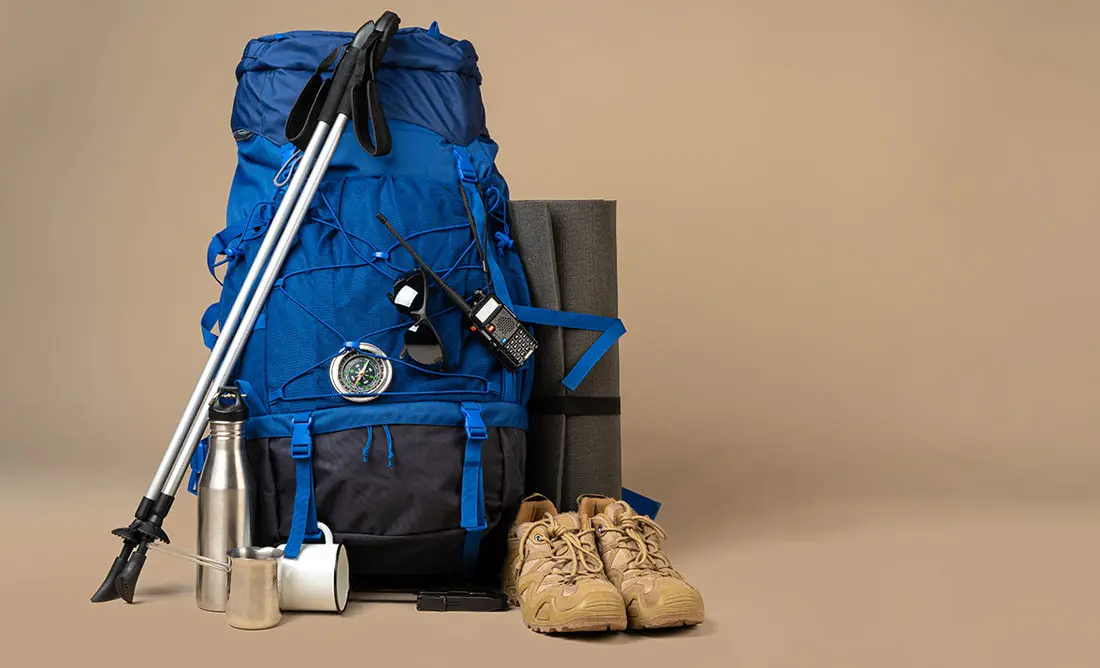
Frequently Asked Questions(FAQ)
To register with TTH, visit our website - www.trekthehimalayas.com and create your account. To create your account you will need to use your email address and fill in all the details, set your unique password and your account is ready to use.
- To book a trek with TTH, you first need to register with us and create an account.
- Choose the trek that you want to do and click on available dates.
- You will land at the login page, fill in the required details.
- Add Participants, choose add-on services click on the Pay now button, choose your preferred payment method, and make the payment. TTH accepts multiple payment options, including credit/debit cards, net banking, and UPI.
- You will receive a confirmation email from TTH with all the necessary details about the trek, including the meeting point, transportation, accommodation, and other important instructions.
- Click Here to watch Video
please send an email to us at info@trekthehimalayas.com or reach out to the numbers provided in the Help and Support section of your Trek Page. We will ensure that your issue is promptly resolved.
To book services such as off-load luggage and transportation, you can find them listed as add-ons. These additional services can be booked at the time of your initial booking. If you miss booking add-ons during the initial reservation, you can log in anytime and easily book 4 days before the departure date add-ons through the platform.
If you have booked the wrong trek or selected the wrong date, don’t worry! You can contact us at +91 9368882322 (Monday to Saturday, 10 AM to 10 PM) or email us at info@trekthehimalayas.com. You can also discuss this with your trek coordinator. Please make sure to inform us at least 10 days before the departure of your trek. Only then can we help you reschedule or arrange another trek for you.
We recommend visiting our "Suggest Me a Trek" page. By filling out the form, our experts will contact you with the best possible trek options based on your preferences and experience level. Alternatively, you can reach out to us via email at info@trekthehimalayas.com or give us a call using the numbers provided on our website for personalized assistance and recommendations.
Family treks differ from regular treks by focusing on ease of difficulty, offering shorter durations for younger participants, Kid-friendly and easily digestible foods, child-friendly activities, maintaining a higher guide ratio for diverse age groups, and implementing additional safety measures for families.
Family Trek with Kids recommendation Only Dayara Bugyal and Chopta Chandrashila Trek.
Minimum age for TTH treks is typically 7 years, though this may vary depending on the specific trek.
Yes, you can take a kids to a high-altitude trek with a parent. Discuss with a trek expert before booking a trek.
- Junior trekkers (below 15 years) should have a company of parents/guardians.
- Trekkers between 15 to 18 years can come solo with the disclaimer form signed by parent/guardian.
- Medical & Disclaimer Form (Mandatory Documents) Click here to download medical and disclaimer form
Physical Fitness: Ensure your child is physically fit. Engage them in regular exercise, outdoor activities, and hikes to build stamina and endurance. Hydration: Emphasize the importance of staying hydrated at high altitudes. Encourage your child to drink water regularly, even if they don't feel thirsty. Proper Nutrition: Provide a well-balanced diet with sufficient carbohydrates for energy and foods rich in iron to prevent altitude sickness. Adequate Sleep: Ensure your child gets enough sleep in the days leading up to the trek. Quality rest is crucial for altitude adaptation. Educate on Altitude Sickness: Teach your child about the symptoms of altitude sickness, such as headache, nausea, and dizziness. Encourage them to communicate any discomfort immediately. Appropriate Clothing and Gear: Dress your child in layers to adjust to changing temperatures. Ensure they have appropriate trekking gear, including sturdy footwear. Positive Mindset: Foster a positive mindset. Encourage your child, and let them know it's okay to take breaks when needed. Medical Check-Up: Schedule a medical check-up before the trek to ensure your child is fit for high-altitude activities. Consult with a healthcare professional about any potential health concerns.
TTH takes special care to provide wholesome and nutritious food for children on treks. Here are some of the foods that are typically served for children:
Breakfast: For breakfast, TTH serves a variety of options like porridge, cornflakes, bread, butter, jam, honey, boiled eggs, omelettes, and pancakes. Children can choose from these options to fuel themselves for the day's trek.
Lunch: For lunch, TTH serves lunch which includes rotis, vegetables, rice, dal, and salad. The rotis are usually made fresh on the trek and are a good source of carbohydrates. The dal and vegetables provide protein and other essential nutrients.
Snacks: TTH provides healthy snacks like fresh fruits, dry fruits, energy bars, cookies, and biscuits to keep the children energized throughout the day.
Dinner: For dinner, TTH serves a hot and wholesome meal which includes soup, rice, dal, vegetables, and a non-vegetarian dish (if requested in advance). Children can also choose from a variety of desserts like custard, jelly, and fruit salad.
Dietary requirements: If a child has any special dietary requirements, TTH can cater to those needs as well. For example, if a child is lactose intolerant or allergic to nuts, the kitchen staff can make arrangements to accommodate those requirements.
Choosing the right trek for a beginner can be a bit overwhelming as there are many factors to consider such as distance, elevation gain, terrain difficulty, weather, and time of year. Here are some tips that can help you choose the right trek for a beginner:
1. Determine fitness level: Assess the fitness level of the beginner to understand their physical capabilities. This will help you select a trek that is challenging but not too difficult.
2. Choose a well-traveled trail: A well-traveled trail will have more amenities such as signposts, water stations, and shelter. It is also safer as there will be other hikers on the trail.
3. Consider the length of the trek: For beginners, it is recommended to start with a shorter trek that can be completed in a day or two. This will help them get acclimatized to trekking and build their confidence.
4. Look for gradual elevation gain: Choose a trek with a gradual elevation gain rather than steep ascents. This will make the trek easier and more enjoyable.
5. Check the weather: Check the weather forecast before selecting a trek. Avoid treks during the monsoon season or winter when the trails can be slippery or dangerous.
6. Research the trail: Read about the trail to get an idea of the terrain, altitude, and difficulty level. This will help you select a trek that is suitable for the beginner.
7. Consult with an expert: If you are unsure about which trek to choose, consult our trek expert Mr. Nitin (+91 70600 59773) between 10 AM to 6 PM (Tuesday - Friday). Mr. Nitin will provide you valuable advice and guidance.
Overall, it is important to choose a trek that is enjoyable, challenging but not too difficult, and suitable for the beginner's fitness level and experience.
It is not recommended for a beginner to choose a difficult Himalayan trek. Trekking in the Himalayas can be physically and mentally challenging, especially if you are not used to the high altitude, steep slopes, and rugged terrain. Choosing a difficult trek without the proper experience, fitness level, and preparation can be dangerous and put you at risk of altitude sickness, injury, and other hazards.
If you are a beginner, it is recommended to start with an easier trek and gradually build up your skills and experience. This will help you understand the challenges of trekking in the Himalayas, and also prepare you physically and mentally for a more difficult trek in the future. It is also important to choose a trek that matches your fitness level, experience, and interest.
There is no specific age limit for a beginner trekker. However, it is important to consider your physical fitness, health condition, and personal interests before embarking on a trek. Trekking in the Himalayas can be physically and mentally demanding, and requires a certain level of physical fitness and endurance.
If you have any pre-existing medical conditions or are above a certain age, it is recommended to consult with a doctor before embarking on a trek. It is also important to listen to your body and take breaks as needed during the trek to prevent exhaustion or injury.
We recommend visiting our "Suggest Me a Trek" page. By filling out the form, our experts will contact you with the best possible trek options based on your preferences and experience level. Alternatively, you can reach out to us via email at info@trekthehimalayas.com or give us a call using the numbers provided on our website for personalized assistance and recommendations.
Yes, you can join the trek. We have fixed departure groups where you can simply book your trek and we will take care of curating a group.
Before you start the trek, it is recommended that you make all the necessary phone calls as during the trek you may or may not receive network coverage, once you come back to the Base Camp, you can reconnect with your family via phone once again. You can share your trek coordinator contact detail with your family members to get the latest updates about your trek batch.
At TTH, we provide wholesome and nutritious meals during the trek. The food is vegetarian and includes a variety of dishes such as rice, dal, vegetables, chapati, paratha, pasta, noodles, and soup. We also offer snacks such as biscuits, and salty, and dry fruits during the trek. Special dietary requirements such as vegan, gluten-free, or Jain food can also be arranged if informed in advance.
If you are allergic to some foods, you need to let us know in advance so that we can make arrangements accordingly.
TTH is a trekking company that prioritizes the safety of all its participants, including women trekkers. We have a comprehensive safety system in place, which includes a dedicated team of experienced and trained trek leaders and support staff who are equipped to handle emergency situations and provide first aid.
TTH also takes specific measures to ensure the safety and comfort of women trekkers. They have a separate tent accommodation for women trekkers, female trek leaders, and support staff. They also provide separate toilet facilities for women and encourage a safe and respectful environment for all trekkers.
Moreover, TTH has a strict policy against any kind of harassment and has a zero-tolerance policy towards such incidents. They have a designated Internal Complaints Committee (ICC) to investigate and address any complaints related to harassment or misconduct. Overall, TTH has a good reputation for safety and responsible trekking practices, and women can feel comfortable and safe while trekking with them.
In case you are the only women in the group, we provide a single sleeping arrangement. Also, during the trek, the trek leader will always remain by your side to provide optimum safety and reassurance.
You can reach out to the trek coordinator to inquire about the number of female trekkers and their respective states who have booked the trek. Please note that the trek coordinator cannot disclose personal details of any trekker. Once you've confirmed your booking, a WhatsApp Group will be created for all the trekkers in your batch. This allows you to connect with fellow trekkers before the trek begins.
While many of our treks are led by female trek leaders, however, it is not possible to know which trek leader is assigned to which group. But nonetheless, whether the trek leader is male or female you can be completely assured of your safety and security with us.
Yes, it is possible to trek with periods. However, it is important to take some extra precautions and preparations to ensure a comfortable and safe trekking experience. Here are some tips that can help you trek during your period:
1. Use menstrual hygiene products that you are comfortable with, such as tampons, pads, or menstrual cups. It is recommended to carry enough supplies for the entire duration of the trek.
2. Pack wet wipes, hand sanitizer, and plastic bags to dispose of used hygiene products.
3. Wear comfortable and breathable clothing that allows for easy movement and reduces friction. Avoid wearing tight or restrictive clothing that can cause discomfort.
4. Carry pain relief medication, such as ibuprofen or acetaminophen, in case of menstrual cramps.
5. Stay hydrated and maintain a balanced diet to support your energy levels and overall health.
6. Take breaks as needed and listen to your body. If you feel uncomfortable or experience any unusual symptoms, seek medical attention immediately. It is also recommended to consult with a doctor before going on a trek during your period, especially if you have a pre-existing medical condition or are taking medication.
By taking necessary precautions and being prepared, you can have a safe and comfortable trekking experience even during your period. We provide proper disposal facilities for sanitary pad disposal during the trek.
We offer three person tents with twin-sharing for optimum comfort. A woman trekker will share a tent with another woman trekker and if you are the only woman in the group, you will be given a single accommodation for your comfort and privacy.
Yes, we do provide gears on rent. You can book it using you TTH account directly.
Mountaineering qualified Experienced and first aid certified Trek Leader, First Aid Certify local guide, Cook, helpers and supporting staff.
People suffering from Bronchitis, Asthma, High blood pressure, Epilepsy (got faints), TB , Heart problem or on higher BMI side are strictly not allowed to go on any Himalayan trek. Apart from this if you had any medical history, please let us know.
No. Alcohol and smoking isn’t allowed while on trek. It is totally misconception that it will keep you warm. Your body need to acclimatize properly and for that eat properly and drink enough water; these things will keep you warm.
Toilet tents provide a convenient solution for answering nature's call in the great outdoors. Dry toilets, in particular, offer a highly sanitary approach. By digging a pit and utilizing mud and a shovel, you can easily cover up your waste. This method ensures cleanliness and hygiene while camping or exploring in the forest.
Remember to pack essential toiletries to complete your outdoor bathroom kit and maintain proper personal hygiene during your adventures. With these practices in place, you can enjoy nature while also respecting it.
Layer Up From Head To Toe
Eat Full Meals, never sleep empty stomach
You can keep warmee (if you’re more susceptible to cold).
Use sleeping bag in right way and don’t leave free space in sleeping bag.
For upper body
– Thermal layer
– T-shirt (full-sleeves)
– Fleece T-shirt (for extreme colds)
– Fleece layer
– Thick Jacket/Down Jacket
– Waterproof or Windproof layer (outermost layer, when it is snowing or raining)
- For Lower Body
– Thermal layer
– Hiking pants (normal) or Winter hiking pants
Based on how warm you feel you can skip any of the above layers. Your outer later should be windproof since it is windy at high altitude.
The idea behind layering is that the more insulation you have the less cold you feel, and instead of wearing a very thick jacket if you wear multiple layers, your body will be better insulated against the cold.
Yes, we provide micro spikes and gaiters, if required.
Mandatory documents: 2 xerox of ID having address (addhar card/driving license), 2 Passport size photographs, hard copy Medical form signed & sealed by doctor, disclaimer form sign by trekker and high altitude insurance.
No. We don’t but we can suggest you good hotel/Stay nearby pick up location.
Yes, trekker must carry 2 water bottles 1 litre each so they can refill it at campsite for drinking and keep themselves hydrate.
You should buy shoes which has these three features –Good grip, Ankle Support and additional water resistant layers. Generally, we advise Quechua Trek 100, MH 500 and MH 100.
No one is forced to go on. There is always enough staff to split the party according to need and regroup later at the camp. Most people have no trouble reaching the highest campsite. If some members decide not to climb the final distance they can wait for the climbers to come back down the same way or take a lateral path to the descent route.
Kareri Lake is situated at a height of 9,650 feet (2,950 meters) above sea level, making it the highest point reached during the Kareri Lake trek. The journey to this beautiful alpine lake takes you through scenic landscapes, dense forests, and charming mountain trails.
Yes, the Kareri Lake Trek can also be done by people over 50. As long as they have good physical fitness and are comfortable with walking long distances, they can enjoy this beautiful trek. It is important to take the journey at a steady pace, rest when needed, and stay well-hydrated. With proper preparation and a positive mindset, people of all ages can have a wonderful trekking experience at Kareri Lake.
The best time to go on the Kareri Lake Trek is during April, May, June, October, and November. During these months, the weather is pleasant and most suitable for trekking. The skies are usually clear, offering breathtaking views of the surrounding mountains and valleys. The trail is also easier to navigate as there is less risk of extreme cold or heavy rainfall. This makes the overall trekking experience more enjoyable and comfortable for adventurers.
No, you don’t need any previous trekking experience to do the Kareri Lake Trek. It is a fairly easy trek, making it a great choice for beginners. The trail is not too steep or challenging, and with a little preparation and basic fitness, anyone with a love for adventure can complete it. The journey is enjoyable, offering beautiful views and a peaceful trekking experience.
The Kareri Lake Trek requires a good level of physical fitness, as the trail includes some steep climbs, downhill stretches, and rocky paths. Trekkers should be prepared for uneven terrain and occasional challenges along the way. Since the trek reaches a high altitude, there is also a chance of experiencing mild altitude sickness. Regular exercise, stamina building, and proper acclimatization can help make the journey smoother and more enjoyable.
Yes, the Kareri Lake Trek is generally safe for trekkers, but like any outdoor adventure, it comes with some risks. The key to a safe and enjoyable trek is proper preparation and caution. It is important to stay hydrated, wear comfortable and weather-appropriate clothing, and choose sturdy footwear for the rocky terrain. Trekking at a steady pace, taking breaks when needed, and not overexerting yourself can also help prevent fatigue or injuries. If you are trekking in a group or with a guide, sticking together and following safety guidelines will make the journey even safer and more enjoyable.
Accommodation during the Kareri Lake Trek usually consists of either camping in tents or staying in simple lodges along the way. Since the trek takes you through remote areas, it is important to be prepared for basic living conditions and carry necessary essentials for a comfortable stay.
The Kareri Lake Trek is known to be an easy-level trek, making it a great choice for beginners who want to experience trekking for the first time. The trail is not too challenging, and with a little preparation, most people can complete it without difficulty. At the same time, those who have some trekking experience will also find it enjoyable, as the route offers stunning natural beauty, peaceful surroundings, and a refreshing adventure in the mountains.
The Kareri Lake Trek covers a total distance of around 26 kilometers. The journey is spread over three days, allowing you to walk at a steady pace while enjoying the scenic beauty along the way. The trail passes through lush green forests, rocky paths, and small mountain streams, making the experience both exciting and refreshing.
The Kareri Lake Trek offers many unforgettable experiences along the way. One of the main highlights is walking through the charming Kareri village, where you can see traditional houses and experience the simple mountain lifestyle. The trail also takes you through dense forests filled with tall pine and oak trees, creating a peaceful and refreshing atmosphere. As you climb higher, you pass through beautiful high-altitude meadows with beautiful views all around. The ultimate reward is reaching the pristine Kareri Lake, a crystal-clear water body surrounded by the majestic Dhauladhar Range, making the journey truly magical.
The Kareri Lake Trek involves a gradual altitude gain, with the lake sitting at a height of 9,650 feet above sea level. Because of this, there is a moderate chance of experiencing altitude sickness, especially for those who are not used to high-altitude trekking. Symptoms may include headaches, dizziness, or shortness of breath. To reduce the risk, it is important to acclimatize properly by taking breaks, walking at a steady pace, and allowing your body to adjust. Staying well-hydrated, eating nutritious food, and avoiding overexertion can also help ensure a safe and comfortable trekking experience.
Yes, the Kareri Lake Trek is suitable for beginners and can be completed by those who are new to trekking. However, a basic level of fitness is necessary, as the trail includes some rocky paths, boulder sections, and steep climbs. Since the trek also takes you to a higher altitude, it is important to be well-prepared to ensure a smooth and enjoyable journey. Regular exercise, stamina building, and proper packing of essentials like warm clothing, sturdy shoes, and enough water can make the experience more comfortable and rewarding.
The Kareri Lake Trek takes about three days to complete, starting and ending in Dharamshala. During this journey, you will get to explore the scenic beauty of the region while making their way to the stunning Kareri Lake. The trail passes through charming villages, dense forests, and scenic mountain landscapes, offering a peaceful and refreshing experience. Along the way, you will cross small streams, walk through lush green meadows, and enjoy the fresh mountain air.
Himachal Pradesh Trekking offers many amazing trekking options for adventure lovers. Some of the other popular treks in the region include Beas Kund, Buran Ghati, Bhrigu Lake, Sar Pass Trek, and Rupin Pass, among many others. Each trek has its own unique charm, with stunning landscapes, breathtaking views, and exciting trails to explore.
.webp)
.webp)
.webp)
.webp)
.webp)
.webp)
